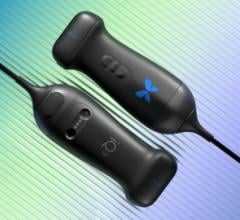
Stephanie Wilson, M.D. (Photo: Business Wire)
October 5, 2021 — Ultrasound experts urged the health care community to work to expand utilization of ultrasound contrast agents (UCAs) in order to offer patients broader access to low-cost, safe and reliable diagnostic imaging.
“UCAs are currently approved for imaging the heart and liver in adult and pediatric patients, and additionally for imaging the urinary tract of pediatric patients,” according to Stephanie Wilson, M.D., who spoke at the 35th Advances in Contrast Ultrasound conference in its opening plenary session in Chicago. Wilson is a professor of radiology and gastroenterology at the University of Calgary and Co-President of the International Contrast Ultrasound Society (ICUS).
According to Wilson, UCAs are versatile imaging agents that also are useful for imaging tumors and organ systems throughout the body, including the kidney, bowel, breast, pancreas, prostate and carotid arteries.
“After decades of safe and routine use of UCAs in modern medical centers around the world, it is clear that adult and pediatric patients benefit from broader use of UCAs to enhance diagnostic ultrasound exams,” she added.
According to Wilson, a single intravenous injection of a UCA will show multiple organs throughout the body, and several organs may be involved with the same pathology.
“It makes absolutely no sense to ignore pathology that is clearly seen in adjacent organs simply because the FDA has only approved ultrasound contrast agents on an organ-by-organ basis, instead of providing a more clinically logical approval for whole body imaging,” she said.
Doctors expanding UCA uses
Doctors are increasingly using UCAs for unapproved uses and professional guidelines now support these additional indications, according to Richard G. Barr, M.D., who also spoke during the plenary session. Barr is editor-in-chief of the Journal of Ultrasound in Medicine, a professor of radiology at Northeast Ohio Medical University, and a member of the ICUS board of directors.
“Doctors are permitted to use approved drugs for unapproved uses if they believe doing so is medically supported and appropriate for their patients,” he said.
Barr also noted that doctors are now reimbursed for unapproved “off-label” uses of UCAs.
According to Wilson, contrast-enhanced ultrasound (CEUS) is a radiation-free imaging technique that is often equivalent or superior to more expensive imaging tools like MR or CT. She said CEUS also allows for dynamic and repeat examinations, is highly effective for monitoring a patient’s response to therapy, and unlike MRI and CT it can be used in patients with kidney failure or allergy to iodinated contrast agents used in CT.
Wilson noted that CEUS is a dynamic, real time scanning tool that offers a highly reliable method of imaging all soft tissue tumors in the abdomen and pelvis, and allows physicians to identify, characterize and stage tumors of the liver, kidney, prostate, breast and other organ systems.
In addition, CEUS of the heart and carotid arteries can help doctors assess cardiovascular abnormalities and stratify a patient’s risk of heart attack or stroke, according to Steven Feinstein, M.D., director of the conference. Feinstein is also Co-President of ICUS and a professor of cardiology at Rush University Medical Center in Chicago.
“Ultrasound is an extremely valuable front-line imaging tool that offers real time, almost immediate results, so patients can get a speedy diagnosis and quicker access to appropriate therapy,” he said. “When UCAs are used to enhance the ultrasound scan, clinical outcomes are often improved, redundant downstream tests may be avoided, overall diagnostic imaging costs may be reduced, and hospital workflows may become more efficient.”
UCAs are radiation-free imaging agents
UCAs (sometimes also known as “ultrasound enhancing agents”) are biocompatible imaging agents that are injected during an ultrasound scan to enhance the resolution of an ultrasound image. They contain microscopic gas-filled microbubbles that are smaller than red blood cells. These microbubbles reflect ultrasound signals as they flow unimpeded through the body’s circulation and are expelled from the body within minutes after injection.
UCAs contain no dye and present no known risk of liver or kidney damage. In addition, while CT and MRI procedures sometimes require sedation to limit the movement of patients, especially children, sedation is not required during the CEUS exam.
UCAs also have an extremely favorable safety profile, according to Michael Main, M.D., Saint Luke’s Health System Senior Vice-President and CEO of Saint Luke’s Physician Group in Kansas City.. Dr, Main is an expert on UCA safety.
“A large body of scientific data now makes it clear that UCAs are extremely safe for the overwhelming number of our patients, across a wide range of medical uses,” he said.
Three UCAs are currently used in the United States -- Definity (Lantheus Medical Imaging), Lumason (Bracco) and Optison (GE Healthcare).
Whole body approval
Wilson and Barr called on the FDA to work with UCA manufacturers on expanding approved uses of UCAs for whole body imaging.
“Limited regulatory approvals restrict opportunities for professional education and vendor-specific professional training, and this ultimately hampers patient access to optimal diagnostic imaging,” according to Barr.
He said that broader approved uses would also expand labeling information and instructions for optimal use.
Physicians are generally allowed to discuss off-label uses during educational presentations, according to Barr, but vendors are limited in their ability to promote off-label uses, even based on studies in respected medical and scientific journals, unless they do so in response to an unsolicited question and follow strict compliance requirements.
“Remember that these are systemic agents. If you are looking at the liver and you happen to see something in the kidney, are you supposed to pretend you didn’t see it?” he asked.
“The only practical difference between CEUS imaging of the liver -- which is approved -- and CEUS imaging of the neighboring kidney -- which is not yet approved -- is moving the external ultrasound transducer,” Barr added.
Cardiac imaging would also benefit from more holistic regulation and approval of these agents, according to Thomas Porter, M.D., Chair of Cardiology at the University of Nebraska Medical Center in Omaha. Porter also is a member of the ICUS Board and a leading expert in off-label use of CEUS for stress echocardiography and cardiac perfusion imaging.
“It is clear that CEUS can play a pivotal role in accurately diagnosing cardiovascular disease, and broader approvals for these agents would align with standards of care that are well established throughout the world,” Porter said.
For more information: www.ICUS-SOCIETY.org


 April 24, 2024
April 24, 2024 








